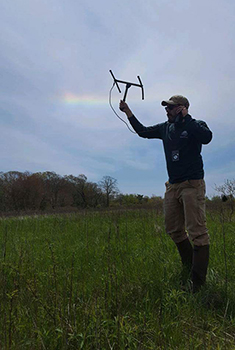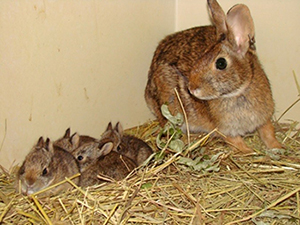New England Cottontail Restoration
Two species of cottontail rabbits are found in Connecticut: New England cottontail (Sylvilagus transitionalis) and eastern cottontail (Sylvilagus floridanus). Of these two species, only the New England cottontail is native. Eastern cottontails were introduced from other states to bolster cottontail populations in the late 1800s and early 1900s. The New England cottontail relies on young forests and shrublands for its survival, while the eastern cottontail has adapted to a wider variety of habitats.Once common throughout most of New England and eastern New York, the New England cottontail population has declined. Its historic range has decreased by 85%, mainly due to habitat loss. In 2006, the rabbit was considered for listing under the federal Endangered Species Act.

The New England cottontail is the only rabbit that is native to Connecticut.
Photo by Tom Barnes.
New England cottontails do not venture far from the heavy cover. They are typically found in abandoned, filled-in beaver ponds; railroad right-of-ways; power-line corridors; abandoned farms; and young forests. These thick, shrubby habitats, known as “thickets,” provide woody browse throughout winter and protection from bad weather and predators. Thickets must be fairly large and close to other thickets so that young rabbits can successfully find their own territories and mates. Small or poor-quality habitat make New England cottontails more vulnerable to predators because the rabbits must venture farther from protective cover to feed.
Cottontail rabbits are a regulated game species in Connecticut, New York, Massachusetts, and Rhode Island. Research in Connecticut has shown that hunting has little effect on the cottontail population. Most cottontails are killed by predators like hawks, foxes, bobcats, coyotes, and weasels.
What Is Being Done?
In 2009, state, federal, and non-governmental organizations in New England and New York began working together to keep the New England cottontail from becoming a federally listed endangered species. This involves creating habitat on state and private lands, monitoring habitat, landowner outreach, and conservation breeding programs.
A comprehensive Conservation Strategy for the New England Cottontail outlines specific objectives for habitat creation and enhancement, land protection, research, monitoring, population management, education and outreach. Each year regional partners report on progress made toward those objectives in an annual performance report.
In September 2015, the Secretary of the Interior announced that due to these extraordinary efforts, the New England cottontail would not be listed. However, a critical factor in reaching this decision was that conservation efforts continue.
Cooperative efforts between the CT DEEP, U.S. Fish and Wildlife Service, Natural Resources Conservation Service (NRCS), Wildlife Management Institute, other state wildlife agencies, and non-governmental organizations have resulted in seven grants which have funded habitat restoration, outreach and education, and monitoring and assessment.

Field technician Tim McKinney holds a juvenile cottontail rabbit.
Photo by Molly Tassmer.

Conservation focus areas help biologists and habitat managers concentrate efforts in areas where they will have the greatest effect. Almost all known New England cottontail populations in Connecticut occur within the focus areas.
State Lands Habitat Management
Efforts are currently underway to create and maintain habitat for New England cottontails on state lands. Sites were selected based on a screening process and known locations of New England cottontails. Habitat restoration involves conducting timber harvests that result in dense regeneration, as well as plantings and non-native invasive plant control. Habitat enhancement follows New England cottontail Best Management Practices (BMPs). BMPs are updated periodically to incorporate the most recent scientific research, and offer guidelines for when and how to cut trees, clear invasive plants, and encourage new growth in a way that avoids impact to existing New England cottontail habitat and populations. We also follow CT DEEP Forestry Division’s BMPs to maintain water quality during timber harvests. Before conducting habitat management, the DEEP National Diversity Database is consulted to ensure the work will not impact any endangered or threatened plants or wildlife. Areas like steep slopes are avoided and sensitive ecosystems, like vernal pools or trout streams, are buffered to maintain the quality of these critical habitats.
At one of our sites, Roraback Wildlife Management Area in Harwinton, a demonstration trail was created to highlight management techniques and habitat features important to wildlife. View the Demonstration Trail Guide.
All of our work on state lands are open to the public. If you’d like to see our habitat restoration at work, visit these properties.
Private Lands Habitat Management
Ninety percent of Connecticut’s lands are privately owned, so the involvement of private landowners is critical. Through the Natural Resources Conservation Service’s Environmental Quality Incentives Program, the Wildlife Division and NRCS are working together to locate interested landowners within conservation focus areas to develop management plans.
Read more about young forest habitat projects, including ones in Connecticut.
Interested landowners can find more information on the Connecticut NRCS Environmental Quality Incentives Program website or contact the NRCS through your local field office.
You may also contact the Connecticut Wildlife Division's Habitat Management Program for more information:
- Telephone: 860-295-9523
- Tanner Steeves, NEC Project Wildlife Biologist: tanner.steeves@ct.gov
- William Cassidy, NEC Project Wildlife Biologist: william.cassidy@ct.gov
New England Cottontail Research Activities
Wildlife Division staff has been conducting research, monitoring, assessment, and distribution studies for more than a decade throughout Connecticut. The resulting information has helped us create conservation focus areas, and also choose where to create habitat and focus landowner outreach efforts. Data has been obtained through hunter harvests, roadkill collections, live-trapping, radio-telemetry, and fecal pellet sampling.

Field technician Josh Tracy uses radio telemetry equipment to track New England cottontail rabbits fitted with radio transmitters.
Photo by Justin Church.
Preliminary Research Results
- New England cottontails are only found in certain parts of the Connecticut, while eastern cottontails are found throughout the state.
- New England and eastern cottontails often live in the same patches.
- Only about 12% of the cottontails in Connecticut are New England cottontails.
- Large, high-quality habitats allow cottontails to have small home ranges, which increases their chances of survival.
- Poor-quality habitat forces New England cottontails to travel farther to meet all of their survival needs. A large home range makes them vulnerable to predators like raptors, foxes, bobcats, coyotes, and weasels.
The Wildlife Division has several ongoing research projects to learn more about New England cottontail. Currently, we are evaluating the success of habitat restoration efforts on state lands; studying interactions between New England and eastern cottontail; and determining precise habitat requirements of New England cottontail.
Along with our conservation partners in other states, we are involved in a region-wide effort to monitor changes in New England cottontail distribution over time.
Conservation Breeding Program
The University of Rhode Island, University of New Hampshire, Roger Williams Zoo in Rhode Island, and the Queens Zoo in New York are involved in a conservation breeding program. This project provides a source of New England cottontails for reintroduction at existing or restored habitat patches.

New England cottontail rabbits at the Roger Williams Zoo in Rhode Island.
Photo by Lou Perrotti.
Additional Information
- Cottontail Fact Sheet
- Best Management Practices - New England Cottontail
- A Landowner's Guide to New England Cottontail Management
- USFWS New England Cottontail Fact Sheet
- New England Cottontail (part of the Young Forest and Shrubland website)
- Managing Grasslands, Shrublands, and Young Forest Habitats for Wildlife: A Guide for the Northeast
- Benefits of Clearcuts Brochure
- The Young Forest and Shrubland Project
Newsletters
- New England Cottontail Newsletter -- published by the New England Cottontail Outreach Working Group starting in 2023
- Young Forest Initiative Newsletter (Editions from 2017 through 2019)
- NEC Project Newsletter (Editions from 2012 through 2016)
Ongoing Habitat Restoration Work On State Lands
All of our work on state lands are open to the public. If you would like to see our habitat restoration at work, visit these properties:
| State Property | Town | Year Completed |
|---|---|---|
|
Roraback WMA |
Harwinton | 2009, 2011 |
|
Roraback WMA |
Harwinton | 2011, 2014 |
| Housatonic River WMA (North Kent Road) |
Kent | 2011 |
| Housatonic River WMA (South entrance off Route 7) |
Kent | 2011, 2013 |
| Goshen WMA | Goshen | 2011, 2022 |
| Camp Columbia SF | Morris | 2008, 2011, 2014, 2016 |
| Sessions Woods WMA | Burlington | 2013 |
| Bear Hill WMA | Bozrah | 2008, 2013 |
| Pachaug SF (Wyasupp Road) | North Stonington | 2006, 2013, 2014 |
| James V. Spignesi, Jr. WMA | Scotland | 2002, 2009, 2015 |
| Pease Brook WMA | Lebanon | 2018 |
| Zemko Pond WMA | Salem | 2010, 2018 |
| Aldo Leopold WMA | Southbury | 2018 |
| Bartlett Brook WMA | Lebanon | 2016 |
| Mad River FCA | Winchester | 2018 |
| Wyantenock SF (Route 341) | Warren | 2015 |
| Assekonk Swamp WMA | North Stonington | 2017 |
Content last updated in February 2024.

